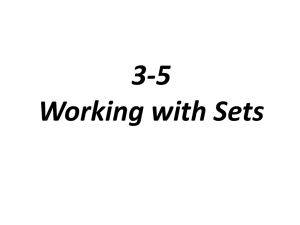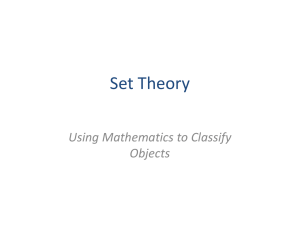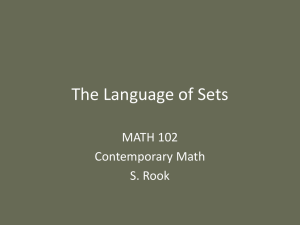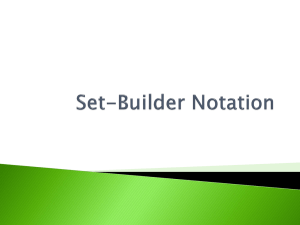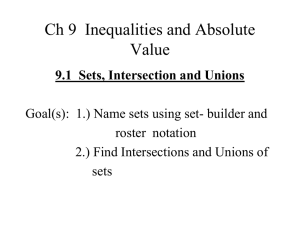Module2_Sets_and_Numbers
advertisement
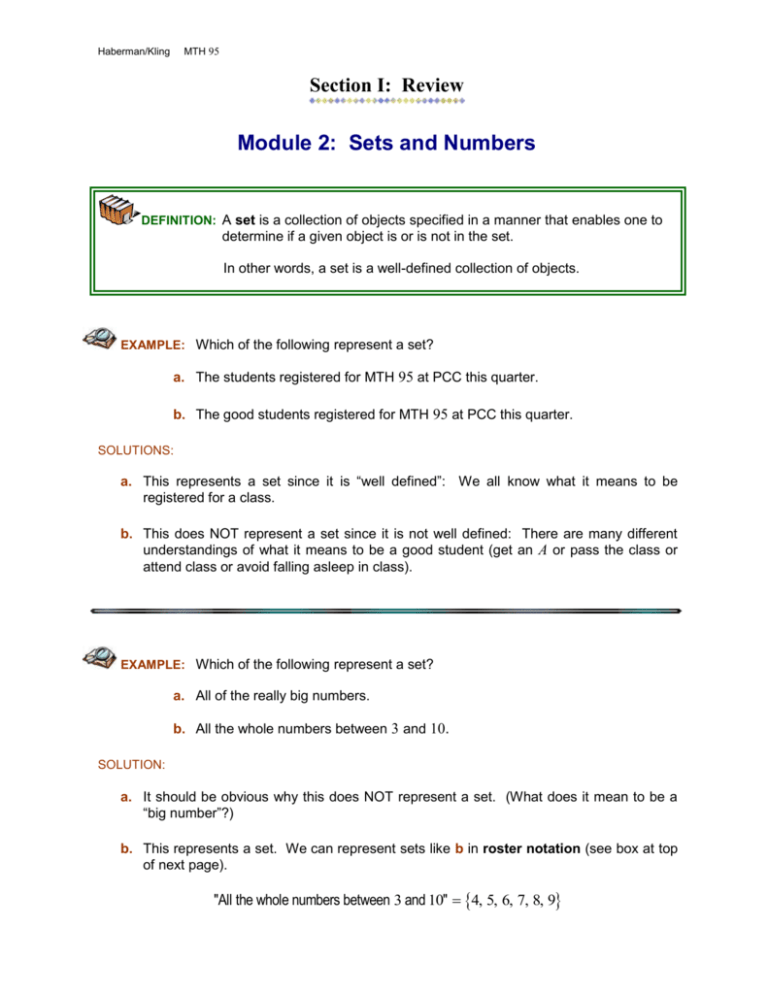
MTH 95
Haberman/Kling
Section I: Review
Module 2: Sets and Numbers
DEFINITION: A set is a collection of objects specified in a manner that enables one to
determine if a given object is or is not in the set.
In other words, a set is a well-defined collection of objects.
EXAMPLE: Which of the following represent a set?
a. The students registered for MTH 95 at PCC this quarter.
b. The good students registered for MTH 95 at PCC this quarter.
SOLUTIONS:
a. This represents a set since it is “well defined”: We all know what it means to be
registered for a class.
b. This does NOT represent a set since it is not well defined: There are many different
understandings of what it means to be a good student (get an A or pass the class or
attend class or avoid falling asleep in class).
EXAMPLE: Which of the following represent a set?
a. All of the really big numbers.
b. All the whole numbers between 3 and 10.
SOLUTION:
a. It should be obvious why this does NOT represent a set. (What does it mean to be a
“big number”?)
b. This represents a set. We can represent sets like b in roster notation (see box at top
of next page).
"All the whole numbers between 3 and 10" 4, 5, 6, 7, 8, 9
2
Roster Notation involves listing the elements in a set within curly brackets: “{ }”.
DEFINITION: An object in a set is called an element of the set. ( symbol: “ ”)
EXAMPLE:
5 is an element of the set 4, 5, 6, 7, 8, 9 . We can express this symbolically:
5 4, 5, 6, 7, 8, 9
DEFINITION: Two sets are considered equal if they have the same elements.
We used this definition earlier when we wrote:
"All the whole numbers between 3 and 10" 4, 5, 6, 7, 8, 9.
S is a subset of a set T, denoted S T , if all elements of S
are also elements of T.
DEFINITION: A set
If S and T are sets and S T , then S T . Sometimes it is useful
to consider a subset S of a set T that is not equal to T. In such a
case, we write S T and say that S is a proper subset of T.
EXAMPLE:
4, 7, 8 is a subset of the set 4, 5, 6, 7, 8, 9 .
We can express this fact symbolically by 4, 7, 8 4, 5, 6, 7, 8, 9 .
Since these two sets are not equal, 4, 7, 8 is a proper subset of
can write
4, 7, 8 4, 5, 6, 7, 8, 9 .
4, 5, 6, 7, 8, 9 , so we
3
DEFINITION: The empty set, denoted Ø, is the set with no elements.
Ø={ }
There are NO elements in Ø.
The empty set is a subset of all sets. Note that 0 Ø.
A and B, denoted A B , is the set containing
all of the elements in either A or B (or both A and B).
DEFINITION: The union of two sets
EXAMPLE: Consider the sets
4, 7, 8 , 0, 2, 4, 6, 8 , and 1, 3, 5, 7 .
a.
4, 7, 8 1, 3, 5, 7 1, 3, 4, 5, 7, 8
b.
4, 7, 8 0, 2, 4, 6, 8 0, 2, 4, 6, 7, 8
c.
0, 2, 4, 6, 8 1, 3, 5, 7 0, 1, 2, 3, 4, 5, 6, 7, 8
Then…
A and B, denoted A B , is the set
containing all of the elements in both A and B.
DEFINITION: The intersection of two sets
EXAMPLE: Consider the sets
4, 7, 8 , 0, 2, 4, 6, 8 , and 1, 3, 5, 7 .
a.
4, 7, 8 0, 2, 4, 6, 8 4, 8
b.
4, 7, 8 1, 3, 5, 7 7
c.
0, 2, 4, 6, 8 1, 3, 5, 7 Ø
Then…
These sets have no elements in common,
so their intersection is the empty set.
4
EXAMPLE: All of the whole numbers (positive and negative) form a set. This set is called
the integers, and is represented by the symbol Z . We can express the set of
integers in roster notation:
Z ... , 3, 2, 1, 0, 1, 2, 3,...
Note that Z is used to represent the integers because the German word for
"number" is "zahlen."
Now that we have the integers, we can represent sets like “All of the whole numbers between
3 and 10” using set-builder notation:
SET-BUILDER NOTATION:
"All the whole numbers between 3 and 10" x x Z and 3 x 10
This vertical line means "such that"
Armed with set-builder notation, we can define important sets of numbers:
DEFINITIONS: The set of natural numbers:
N 1, 2, 3, 4, 5,...
The set of integers: Z ..., 3, 2, 1, 0, 1, 2, 3,...
p
The set of rational numbers: Q q p, q Z and q 0
This set is sometimes described as the set of fractions.
The set of real numbers: R (All the numbers on the number line.)
The set of complex numbers: C a bi a, bR and i
1
Note that N Z Q R C , i.e., the set of natural numbers is a subset of the set of
integers which is a subset of the set of rational numbers which is a subset of the real numbers
which is a subset of the set of complex numbers.
Throughout this course, we will assume that the number-set in question is the real numbers,
R , unless we are specifically asked to consider an alternative set.
5
Since we use the real numbers so often, we have special notation for subsets of the real
numbers: interval notation. Interval notation involves square or round brackets. Use the
examples below to understand how interval notation works.
CLICK HERE FOR AN INTRODUCTION TO INTERVAL NOTATION
EXAMPLE:
a.
x
x R and 2 x 3 [2, 3]
Set-builder Notation
Interval Notation
We use square brackets here since
the endpoints are included
b.
x
x R and 2 x 3 (2, 3)
Set-builder Notation
Interval Notation
We use round brackets here since
the endpoints are NOT included.
c.
x
x R and 2 x 3 (2, 3]
Set-builder Notation
Interval Notation
We use a round bracket on the left
since 2 is NOT included.
d.
x
x R and 2 x 3 [2, 3)
Set-builder Notation
Interval Notation
We use a round bracket on the right
since 3 is NOT included.
6
EXAMPLE: When the interval has no upper (or lower) bound, the symbol (or ) is used.
a.
x
x R and x 4 (, 4]
Set-builder
Interval
Notation
Notation
We ALWAYS use a round bracket with
since it is NOT a number in the set.
b.
x
x R and x 4 [4, )
Set-builder
Interval
Notation
Notation
We ALWAYS use a round bracket with
since it is NOT a number in the set.
CLICK HERE FOR SOME INTERVAL NOTATION EXAMPLES
EXAMPLE:
Simplify the following expressions.
a.
4, 8, 3
b.
4, (, 2]
c.
4, (, 2]
d.
4, 10,
5
SOLUTION:
a.
4, 8, 3 [8, )
b.
4, (, 2] (, ) R
c.
4, (, 2] (4, 2]
7
d.
4, 10,
5 Ø
CLICK HERE FOR A SUMMARY OF INTERSECTIONS, UNIONS, SET-BUILDER
NOTATION AND INTERVAL NOTATION WITH NUMBER LINES


